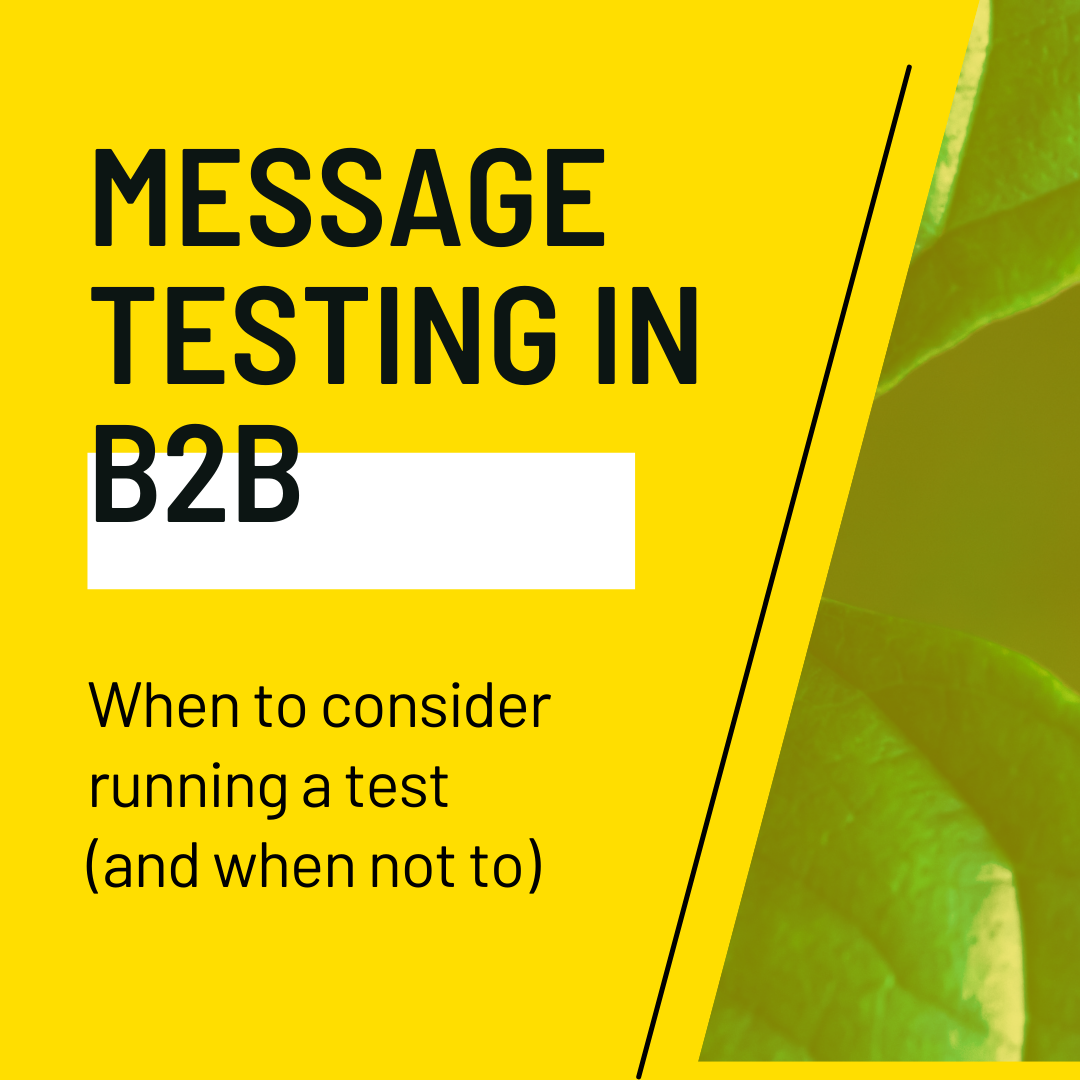5 signs your B2B SaaS startup isn't ready to scale — and how to fix it
Shorten your sales cycle, slash the number of sales calls and improve website conversions (by being clear on your messaging)
Unpopular opinion: moving faster is easier when you have a solid foundation.
It runs contrary to the “move fast and break things” motto — but as you go from startup to scaleup, moving fast and breaking your ad funnels costs conversions without opening up new opportunities.
For the purposes of this post, we’re assuming that you already have happy customers, found MPF and have developed a growth strategy.
If not — running fast and lean experiments makes a world of sense.
But if you’re at the point when it’s all about growth, then read on to find out about a (tragically undervalued) document that’ll take your growth foundations from shaky to rock-solid — and help you scale faster and without driving CAC through the roof.
- A missing growth engine part that’s not so easy to add on as you lift off
- Slow down to speed up your growth — what’s your answer to this “Messaging 101” question?
- 5 answers that mean your growth foundations are shaky (and what happens if you don’t fix them)
- Answers to “Who are we building for?” that add extra meetings (and weeks) to your sales cycle
- Answers to “What are we solving for them?” that can cost you conversions as you scale
- What happens when your answer to “Why should your ICPs even care?” is not VoC-based
- But… is this really a problem? Yes.
A missing growth engine part that’s not so easy to add on as you lift off
A lot of stuff can be added as you scale — ad campaigns, lead magnets, sales enablement documentation, and case studies, to name a few.
But the one thing that’s not that easy to add is a shared understanding of brand messaging and ICPs’ pain points and desired outcomes.
Not having that information is like duct-taping your growth engine together and launching without a key part — understanding your ICPs and which messaging will resonate with them.
Here’s why having that shared understanding is important.
Once you start scaling, your team will start growing and the number of marketing initiatives you launch will grow as well.
Which means it’ll get harder to keep everyone on the same page.
Without a shared understanding of messaging, teams will be making decisions based on their gut instincts, assumptions about your ICPs and your market, and best practices and hacks, not systems.
Or, each team will be wasting their time on running customer research in a silo — without sharing it with other teams or checking their research for possible biases based on what other teams know about prospects and customers.
Result:
Wasted time and effort
Underperforming campaigns
Low conversion rates
Inconsistent messaging
Confusing sales conversations
Long sales cycles
Frustrated prospects
No clear direction for content, growth and sales enablement initiatives
Having your messaging nailed down as you develop your growth strategy will help avoid those issues.
Slow down to speed up your growth — what’s your answer to this “Messaging 101” question?
And the first step is going back to the basics and making sure you have an answer to this one question.
Here’s the question:
“Who are we building this for, what are we solving for them, and why should they even care?”
Really basic, but slowing down and digging in instead of giving lazy answers will take care of your messaging.
When you rush through this stage (or skip it altogether) — because there’s no time to waste when you’re scaling up — this is what I see happen.
5 answers that mean your growth foundations are shaky (and what happens if you don’t fix them)
Here are 5 frequent answers that’ll set you up for a shaky liftoff:
“Who we’re building this for” is based on 50’s-era personas — or a list of positions to target on LinkedIn
“Who we’re building this for” doesn’t have any info on buying triggers, or ways to support their purchasing decision
“What we’re solving for them” is based on the founders’ vision and may not align with new use cases, new ICPs, or the way they think about the problem — or even beliefs about what would work for them
“What we’re solving for them” is not structured into a clear hierarchy of desired outcomes or tied to stages of awareness
“Why should they even care” is based on “well, obviously,” not voice-of-customer data
If your take is “Not my department,” this is what happens when startups scale without taking the time to find more in-depth answers.
Answers to “Who are we building for?” that add extra meetings (and weeks) to your sales cycle
Your answer to “Who are we building this for?” is a demographics-based persona or a list of titles
Good start, buuuut:
What is it they’re trying to achieve?
What has been stopping your ICPs — or their departments — from solving this problem?
What have they tried before (and why didn’t it work)?
Will they believe you when you make your Current Claim™ — based on how they perceive the current competitive landscape (for example, “Email is dead” vs a new ESP on the market)?
Your answer to “Who are we building this for?” doesn’t have any info on buying triggers, or ways to support their purchasing decision
OK, so you know who your sales team is going to reach out to.
In general.
But what if you could:
Get more specific about the window of opportunity for the outreach?
Nurture prospects with content relevant to their “we need a solution” triggers?
Support your sales with right-for-the-moment, right-for-the-ICP content?
Start building out your organic traffic with content clusters that are laser-focused on your prospects’ burning questions, not the latest spreadsheet of keywords?
Entirely possible — but frequently skipped to rely on ad funnels for growth. And even then, ad funnels are targeting prospects with generic claims that don’t lead to conversions (read more below).
Answers to “What are we solving for them?” that can cost you conversions as you scale
Your answer to “What are we solving for them” is based on the founders’ vision and was not updated for new use cases, new ICPs, or the way they think about the problem
Not suggesting that you don’t need a vision statement — of course not!
But as your ICPs read it, they’re going to wonder “What’s in it for me?” — and if there’s no clear connection, then there’s no obvious reason to convert.
Especially if you’re a startup that pivoted as it grew, not updating your answer to this question means confusing messaging and lower conversions.
Your answer to “What are we solving for them” is not structured into a clear hierarchy of desired outcomes or tied to stages of awareness
The bigger your sales and marketing teams get, the more likely it’ll be that everyone will have their own understanding of what prospects and customers care about — based on their own experiences.
Unfortunately, this leaves a lot of room for biases.
This’ll become a problem if your growth strategy is centered around a secondary benefit that is sort-of-kind-of important, but doesn’t solve the burning challenge that’s costing your ICPs’ companies.
Messaging hierarchy helps focus your campaigns and copy on the pain points and outcomes that matter — so that you get more conversions, not bounces.
What happens when your answer to “Why should your ICPs even care?” is not VoC-based
If you’re answering this question with “well, obviously,” it’ll likely translate into generalized or marketing-speak-y headlines, CTAs and feature bullets.
Even if your understanding of the features and benefits is on point, marketing-speak just won’t resonate. This is when you’ll see all the usual suspects show up in web copy or in ads:
“The pioneers of…”
“The future of…”
“One app to rule them all…”
“Developed by … for …”
… and other similar phrases that are shorthand for “We don’t have time to do VoC research”
Unless your product is a 100%-perfect copy of other existing solutions (not likely), your customers will be attracted to it for a number of reasons, from feature differentiators to customer service availability or the way you do business with them.
All of that combined — plus the way they describe their problems and your solution — can get you to the happy place where you no longer have to rely on “The future of…” headlines.
But… is this really a problem? You bet it is!
When there’s no internal alignment on messaging and no understanding of ICPs, then you’re going to be slowed down by:
Shiny objects / new hacks / exciting new ideas taking over your marketing and growth initiatives — so that you waste time on guessing and trying random channels and approaches without a clear blueprint in place
Churning out copy & content that’s just ‘meh’ - because you have no idea what actually matters to your ICPs and what they need to hear to read anything you put out — or go as far as share their email address with you
Scaling without a solid research foundation means getting slowed down by low-performing pages, longer-than-necessary sales cycles, almost-invisible content and not-quite-persuasive-enough sales enablement documents.
The bad news is that there are no research shortcuts.
The good news is that diagnosing your foundation doesn’t need to take a long, long time.
Here’s a quick way to test whether your startup is ready for growth:
Check internal messaging alignment
Check external messaging alignment
The state of internal messaging will tell you if everyone on your team is on the same page. If they are, you don’t have to worry about messaging mismatch or confusing funnels that make prospects bounce right off the page.
If you realize that your team members have very different perceptions of your startup’s value prop, ICPs, and differentiators, it’s much better to find that out now, instead of once your new funnels fail to work.
The state of external messaging helps you flag down messaging discrepancies or inconsistencies that may have sneaked into the copy. Knowing that — and updating the copy now — makes it easier to scale up your growth down the road. Even better, you’ll have fewer variables to keep track of as you start optimizing them for conversions.
I help B2B SaaS startup founders and marketers get more traction with research-driven conversion copy — without slowing down their growth initiatives.
Hire me for:
Website audit to find & fix conversion blockers
Day rates to optimize your landing pages, web copy, or email sequences for more clicks and signups




![[S2E6] How to build a content ecosystem to convert and support users](https://images.squarespace-cdn.com/content/v1/510fa084e4b060f86e73735a/1750284561646-AA8WDFHRFZ32GQO5GI51/S2E6+Podcast+Cover+visuals.png)
![[S2E5] Practical Guide to Wynter Messaging Tests](https://images.squarespace-cdn.com/content/v1/510fa084e4b060f86e73735a/1747226672649-1AU6KQD4RIGSNSIIQLGW/Solo_episode_cover.png)
![[S2E4] How to: message testing on a budget](https://images.squarespace-cdn.com/content/v1/510fa084e4b060f86e73735a/1744221834434-TF0URFQBJNYQPPMKQNHK/alex_atkins_cover_image.png)
![[S2E3] How to: positioning](https://images.squarespace-cdn.com/content/v1/510fa084e4b060f86e73735a/1742493000706-NG82ZT4YFEM2AFCDG03N/S2E3_Josh+Garofalo_COver+Image.png)
![[S2E2] How to find winning angles for your competitor pages](https://images.squarespace-cdn.com/content/v1/510fa084e4b060f86e73735a/1740671619617-YYWZU1UAQOHY3RDFNTIC/YDGW_S2E2.png)
